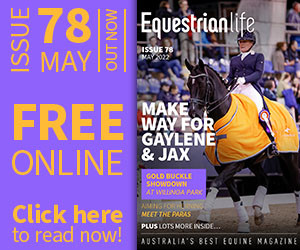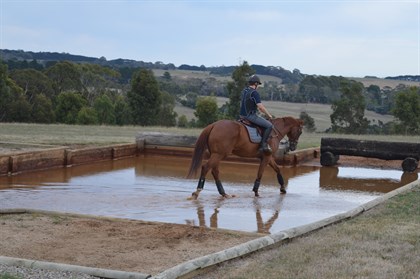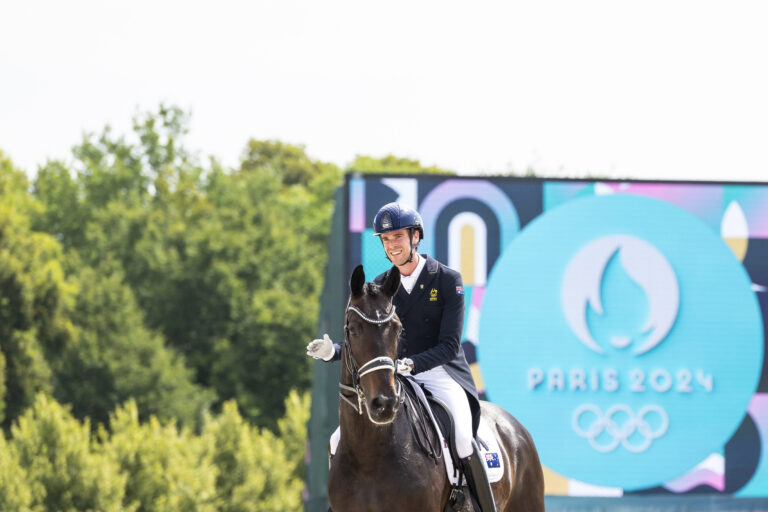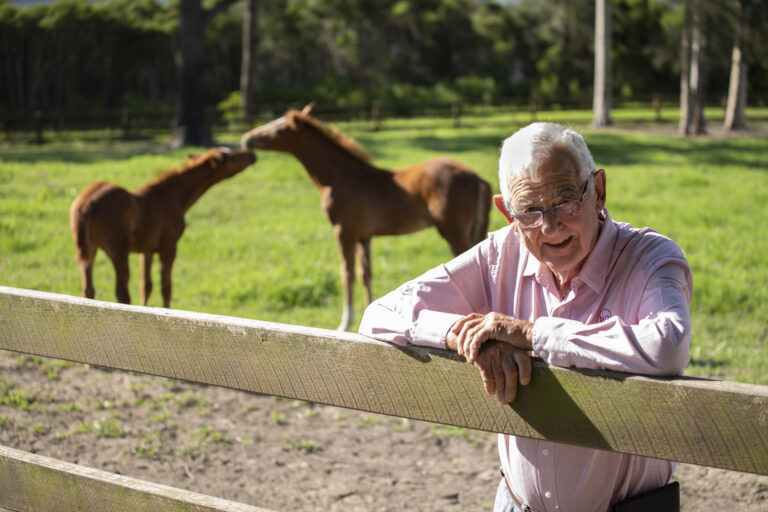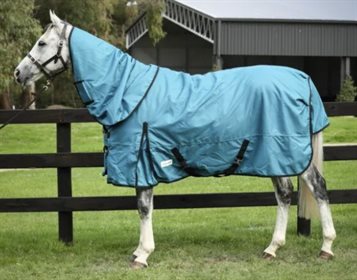The horses were given time to play in the water before jumping in and out. Lucinda wanted everything to be relaxed
© Chloe Chadwick
By Chloe Chadwick
LUCINDA GREEN LAYS down the law: “If you do your job as a rider, your horse will be able to do his.” The four riders clustered around her at her clinic in picturesque Mount Martha are clutching on to every word, ears pealed for every piece of her clear and insightful instruction. World champion, dual European champion, Olympic medallist, record six-time winner of Badminton and twice taking the blue at Burghley, Lucinda’s achievements read like tomorrow’s grocery list rather than the staggering collection of silverware that she has accumulated. Riding since she was four, Lucinda is an eventing great, mother of two and equestrian commentator who shares her vast knowledge world-wide through her sought-after clinics.
“I want everyone to remember ELBow”, Lucinda tells the group. “Nothing to do with your actual elbow – but the acronym that spells out your job. E, you are in charge of the Engine. L, you are in control of the Line, and B, you are also in charge of Balance. Every stride of the cross-country you are watching your horse’s balance, because you want him sound for years to come. You don’t want him tearing around corners, going around in an unbalanced canter.” It’s with this philosophy that Lucinda is an advocate of form and safety, and for the horse. Above all, he has to be comfortable and happy. “And of course the ‘ow’ in ‘ELBow’ is the sound you make if you don’t do your job!” Witty and uncomplicated in her approach, this is what has garnered Lucinda a mass of dedicated followers.
One of these devotees is Kate Fremlin, who is attending her fourth clinic with her horse Jack O Lantern (aka Sweeney); a pair with 1* in their eyes and the talent to back it up. “Lucinda has been fundamental to Sweeney’s development,” Kate says. “From the green baby he was the first year we attended the clinic (before his first season of competition) through until now, Lucinda has helped to encourage Sweeney to be a confident and enthusiastic cross-country partner. We are now successfully competing EA105 and muddled our way through our first 1* recently, and are looking to make the improvements necessary to make a proper move up to 1* in the not too distant future.”
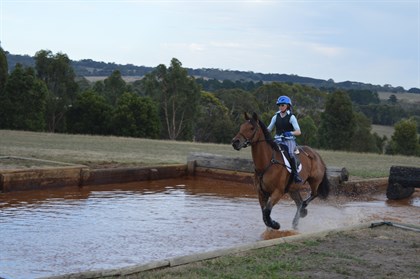
Kate and Sweeney tackle the water confidently
© Chloe Chadwick
Warm Up and Keep it Calm
The session begins with Lucinda inspecting everyone’s gear, making sure both horse and rider are comfortable and happy. In Kate’s group a bit is changed, a noseband taken off, and everyone’s stirrups shortened. “You need to be secure in the saddle. Take those knee blocks out if you can, you want to be able to cuddle the horse with your legs.”
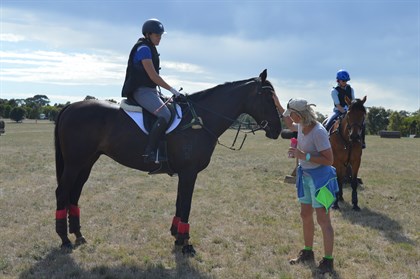
There were some bit and noseband changes, with Lucinda wanting to keep it simple
© Chloe Chadwick
Each session starts with a play in the water with the combinations popping down steps at a walk with a splash. “It’s important that these things can be done at a walk,’’ Lucinda says. “You want your training to be relaxed and comfortable, that way you can translate that confidence to when you’re out on course.”
Contact is Key
One of the most influential techniques that Lucinda asks riders to employ from the get-go is “emergency rein” contact. “An elastic long rein – not a ‘no-contact’, not a loose rein – just a lot lighter” is how Lucinda describes to me her ideal emergency rein contact. It sees the rider with their hands further apart, and allows them to sit back more securely in the saddle. “If you watch the clinic without really an idea of what’s gone on before, you’re thinking: what is everyone doing with their hands out there? There is a very good reason. There are many times when you’re out on a cross-country course where you have to slip the reins and you don’t have the time to pick them up in the next four strides before you’re going over the skinny. It’s one of the many situations you have to practise before you go cross-country – and in this case – overdoing it, because of its benefits,” Lucinda explains.
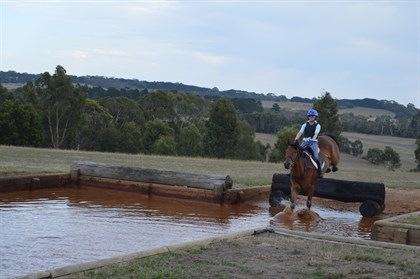
Kate and Sweeney tackle the water confidently, Kate comfortable using emergency rein contact
© Chloe Chadwick
“It benefits a horse’s elasticity, because all the horse has to do is put its head down and the rider’s hands come together. A lot of people hold on with the reins – it’s a bit like riding a bike without hands. A lot of people just don’t feel safe if they haven’t got the short rein, clinging on like a monkey, so that emergency rein contact offers both horse and rider massive benefits. That’s why we look at emergency rein contact and why we do the playing in the water, because more than anything it’s to get them to learn that they don’t need to have their horse in a death grip; that he can still jump on an elastic long rein – not a no-contact, not a loose rein – just a lot lighter, and at the same time it gets the rider sitting in a place where they should be anyhow, because when they’ve got a short rein it pulls them out.”
Through the Horses’ Eyes
After the water play, Lucinda moves the group to the bank, popping over fences with the same relaxed approach before getting riders to make up their own course from the surrounding jumps. Even when they turn the speed up a notch, she encourages them to keep things calm and their seat secure.
We move over to the ditches where in all groups there is a recurring theme of some saying that either they or their horses find ditches a problem. Lucinda sets up a combination with a skinny following the ditch, adding another of many riders’ spooky fences. This makes the riders concentrate on their line and balance, and sets up their horses so they can correctly assess distance and height.

Ditches were a common problem amongst the riders, but Lucinda had most jumping confidently by the end of the day
© Chloe Chadwick
Lucinda speaks passionately about riders remembering their job, and how so much of it is because the rider holds the knowledge. “What I often say to the riders is that it is your responsibility to get the horse to see the fence, and to see it at the earliest possible moment,” Lucinda explains. “That gives him as long as he needs to compute it and read it. I keep trying to impress upon them what everyone knows: the horse has not walked the course, he has no idea. Every time he goes to a fence he has no clue where he’s going or what’s coming up next, and he’s that bloody brave that he goes despite. So it’s our duty to make sure he knows where he is going.”
I notice during the clinic that often when riders are having problems – especially at the “scary” fences such as ditches – Lucinda is quick to point out that, though you might not like your horse having a good look at the fence – let’s face it, it can be nerve-racking when you think he might be about to stop – he also has to be allowed to see it, to understand it, and therefore be able to jump it correctly. When I ask Lucinda about this at the conclusion of the session, and for her trouble-shooting tips, she says: “It is very rare that problems ever stem from a horse being allowed to look for too long, but definitely too late.” She believes in a theory she has learned about horses’ vision. “When horses come in to a fence, they are seeing the distance with the bottom half of their eye, so if they are on the bit they can’t actually see the fence, and this is something a lot of people don’t seem to understand. And as the horse gets close to the fence – if they want to have a quick look at the ditch – it’s the top part of their eye which is used for close vision, so the horse’s head will go through 180 degrees in a split second if they need to.”
This is where Lucinda emphasises the importance of position in making sure you have a secure and fun time cross-country. “Your job as a rider is to never be dislodged from your position of defence in the saddle. So if you are coming to a skinny, for example, and you’re holding quite tight with your hands and not your legs, and then at the last second your horse looks at the fence with the top part of his eye – pitching his head right down – most people who aren’t expecting it get levered out of the saddle, arriving on the horse’s front balance. I think of it like a seesaw – if you sit down, the front has to come up. As soon as you sit near the middle, the other end teeters. When a rider gets pulled by a horse looking – into the middle of the seesaw – the horse finds it hard to pick his shoulders up. So at this stage he’ll either try and pick himself up and jump the fence poorly – probably hitting it – or he’ll put on the brakes.”
Lucinda believes this lack of understanding of horses’ focus leads to problems with tricky fences. “This is where things go wrong: you so often hear people say they hate trakehners, but they’ve actually created the problem because the horse has to look. To jump the fence every horse has to look at it – some look a lot more than others – and the rider isn’t expecting it, and so they go along saying, ‘don’t look, don’t look’, and then they get pulled forward. So I really think riders need to understand more about how their horse focusses, and to realise that sometimes their horse’s head needs to be allowed to go through quite a big angle of movement – 180 degrees is not an exaggeration – to get his eyes where he needs to have them.”
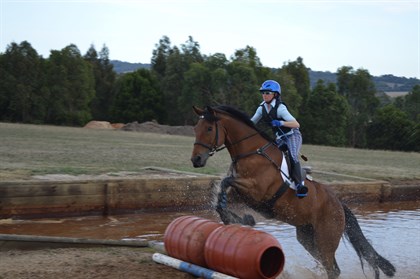
Kate and Sweeney tackle the water confidently
© Chloe Chadwick
Practise Makes Perfect
The sessions are drawing to a close and in every group the riders are looking confident, the horses jumping boldly. One rider and her horse rush through the ditch and skinny combination. “Now that wasn’t very good, go and do it again,” Lucinda says to the combination she knows can do better. It is this theme of repetition, and practising to correct mistakes, that Lucinda impresses at the end of each session. “The best and safest cross-country riders practise their job. When you go out on the cross-country course, nothing should be a surprise. This is how you keep it safe. People often ask me: when do I know when it’s time to move up to the next level? I say: when you are bored. Practise, practise. It should become second nature.”
READ THE LATEST NEWS ARTICLES HERE
